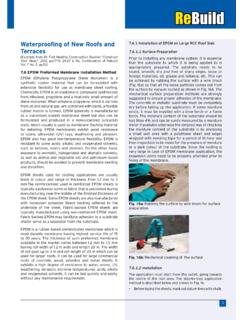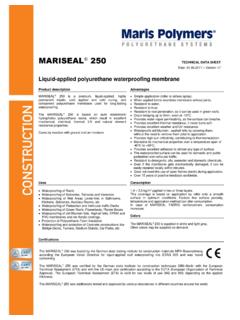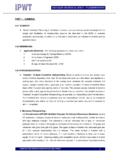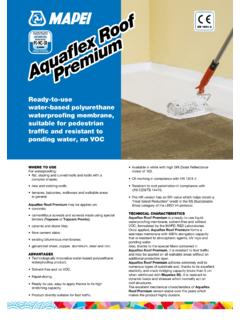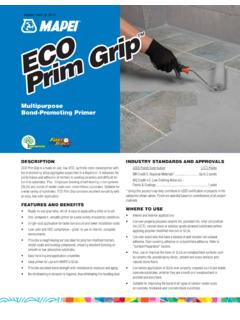Transcription of ADVANCES IN WATERPROOFING MATERIALS & …
1 Vol. 5 No. 1 (Jan-Mar 2011)A Quarterly NewsletterADVANCES IN WATERPROOFING MATERIALS & TECHNOLOGYIn WATERPROOFING White is Green!Leaks and dampness in walls, ceilings, roofs, etc. can certainly be prevented. It is important to appreciate that in a country like ours with its seasonal heavy rainfall, efficient WATERPROOFING of structures should receive the utmost attention right at the time of construction itself. Many builders tend to neglect this primary precaution, notwithstanding the fact that the pre-monsoon repairs soon turn out to be more expensive than pre-planned preventive measures during recent times the increasing cost of new construction as well as of repairs and restoration of constructed buildings, led essentially by escalating raw MATERIALS and labour costs, is making project developers and owners opt for effective and advanced WATERPROOFING products and solutions. There is also an increasing perception amongst the project developers and owners that the long-lasting concrete structures alone should not suffice.
2 The requirement of WATERPROOFING should be coupled with aesthetics and also with the environmental demands .Crystalline WATERPROOFING MATERIALS and flexible membrane WATERPROOFING systems are the two versatile systems that are applied in India and internationally. While the former is used to waterproof and rehabilitate leaky water tanks, swimming pools, retaining walls, etc., the flexible membrane WATERPROOFING systems are mainly applied to waterproof roofs and other exteriors. Apart from the housing projects, WATERPROOFING is being progressively seen as an integral part of infrastructural projects such as the underground tunneling for railways, port structures, marine tanks for sea water desalination plants, hydel projects, etc. In such instances the WATERPROOFING activity demands a high-end solution with more innovative net result of all these demands has been a slow and gradual shift from lime concrete and brick-bat-coba terracing, mud-phaska terracing, foamed concrete terracing, use of site-mixed traditional plasters etc.
3 Instead, the use of bitumen and polymer products has been on the rise. But one should not forget to take note of the fact that these products are known to have significant toxic characteristics. The concept of green building has been increasingly pressurising the architects and structural designers to implement more eco-friendly schemes. The question of toxic effects of some of the new products has to be addressed by the R & D community. WATERPROOFING of low-slope reinforced concrete roof slabs has been a more focused area of development by the research scientists. Apart from the toxicity of the products, the attention is to reduce carbon footprint by replacing non-reflective dark roofing MATERIALS with white ones. Thus, the modern trend in roof WATERPROOFING is based on the concept that white is green . But at the same time one should not fail to notice that some whites may not be as green as others.
4 For example, a reflective bitumen aluminium paint is often used to protect bitumen and torch-on roofing finishes from weather and UV degradation. But aluminium being a very energy-intensive metal, it lacks the real merit of being green .The actual realization of the white-is-green concept has been possible with the introduction of acrylic polymers that have gained a strong foothold in the coatings as a result of their improved flexibility and adhesion with moderate cost. In addition, their reflectance, outdoor durability including resistance to ultraviolet degradation, options of mixing co-monomers to tailormake the required properties, etc. have mandated their use in the roof WATERPROOFING formulations. The acrylic elastomeric products and systems provide seamless waterproof and weather-tight barrier, offering high reflectivity, emissivity and dissipation of heat, while reducing UV light has brought in use the technology of cool roof a term that is used to describe the roofing material that not only waterproofs but also results in high solar reflectance.
5 This property can reduce heat transfer to the indoors and enhance roof durability. Cool roofs may also be highly emissive, releasing a large proportion of the solar energy that a structure absorbs. The cool roof membranes are titanium white 100% acrylic ceramic-impregnated formulation with stringent application specification. In this category one may also find polyurethane fortified acrylic emulsion WATERPROOFING membranes formulated for use under very demanding at the potential of the cool roof technology , it is estimated that if it were possible to turn all the world s roofs white and reflective over the next 20 years, one could see a saving of the equivalent of 24 billion tonnes of carbon dioxide emission. Observing this potential of emission reduction, A. Rosenfield felt an urge to comment: So, in a sense, it s like turning off the world for a year .I hope our readers will find the contents of this issue, devoted to WATERPROOFING , not only interesting but also useful from the perspective of their application theEditor s Desk2 Special Lecture Delivered by Dr.
6 Kribanandan Gurusamy Naidu, MD of JTK Consult Sdn. Bhd, Malayasia on ADVANCES in WATERPROOFING MATERIALS & Technology IntroductionWaterproofing is one of the most important parameters considered in the construction of building and structures to prevent leakages, dampness etc and making the structures durable. For WATERPROOFING latest advanced technologies are being used worldwide. During his presentation, Dr. K. G. Naidu presented how this advanced WATERPROOFING MATERIALS and technologies can help for making durable Concrete Volumetric Proportions and Design AspectsHydration is the major process in the concrete. On addition of water to cement, hydration process starts and during this period, two phases occur. In first phase gel formation of cement takes place which also includes solid hydrated products of cement. In second phase capillaries are formed which consists of water and pores. Besides these there is some cement which never takes part in the hydration process thus forming unhydrated cement.
7 Covercrete is a cover provided to protect the heartcrete and zone of poor quality concrete. Covercrete protects the reinforcement and concrete from chloride attack and sulphate attack. In the design and construction stage of concrete, the specifications and details of concrete should be mentioned and in the construction stage, concrete must be good compacted, proper cover should be provided and proper curing of concrete has to be carried out as per the standards. The covercrete is to be provided to structure as per standards, to resist the environmental attack on buildings and structures. The durable concrete should be designed for low porosity, low permeability and low water absorptivity and Approach to concrete placementThe concrete should have mix design with high workability and cohesive mixed design concrete texture. At the time of placing of concrete, concrete should properly compact with good practice of compaction.
8 After placement of concrete, proper curing and protecting methods should be adopted. For WATERPROOFING concrete, the water/cement ratio should be up to a maximum value of Low PermeabilityFor lower permeability concrete, silica fume which is a by-product of silicon metals or ferrosilicon alloys is used. On addition of silica fume at a dosage of 5 to 8% by weight of 3cement drastically reduces permeability by sealing voids and pores within a concrete Concrete Design for Reducing Water Absorptive and PenetrationTo reduce water absorptive and penetration of concrete, a hydrophobic and pore blocking additives are used in concrete. The hydrophobic ingredients in the material creates a concrete surface which is repellant to water under static conditions and other inert component provides a pore blocking function by positioning themselves in the capillary pores and acting to block ingress of water under pressure (Figure 1).
9 Concrete Design and Other ConsiderationsIn concrete design, one of the major properties is workability of concrete. The workability of concrete should be designed for a minimum slump of 125 mm and preferably of 150 mm. The concrete having proper workability minimizes the risk of honeycombs and poor compaction practices during placement of concrete and it also reduces likelihood of any addition of water at site without authorization. The concrete should mix with proper proportion of MATERIALS which avoids excessive bleeding and possible WaterproofingWaterproofing is defined as a treatment of a surface or structure to prevent the passage of water under hydrostatic pressure as per ACI committee 515 where as damp proofing is defined as a treatment of a surface or structure to resist the passage of water in the absence of hydrostatic pressure. The damp proofing is rather to retard but not to stop the absorption of water or water vapor through concrete or masonry which results into the dampness on structure.
10 To retard dampness or prevent dampness barrier system is to be used. The barrier systems are having two types of systems such as positive side and negative damp proofing the positive side system is used by introducing a barrier between surface and water, which results into less dampness. In negative side barrier Fig. 1: Integral Water Proofers - Pore Blocking Effects4system the barrier is being introduced at the opposite end to prevent the water ingress in to surface of the Building EnvelopeBuilding envelope consists of substructure and super structure with the combination of roofing, WATERPROOFING , damp proofing and joint system and flashing system that act cohesively as a barrier, protecting interior areas from water and weather intrusion. A schematic diagram of building envelope is given in Figure the waterproofed concrete construction, the objective must be not only the individual components of the structure but also to waterproof of the whole structure.



